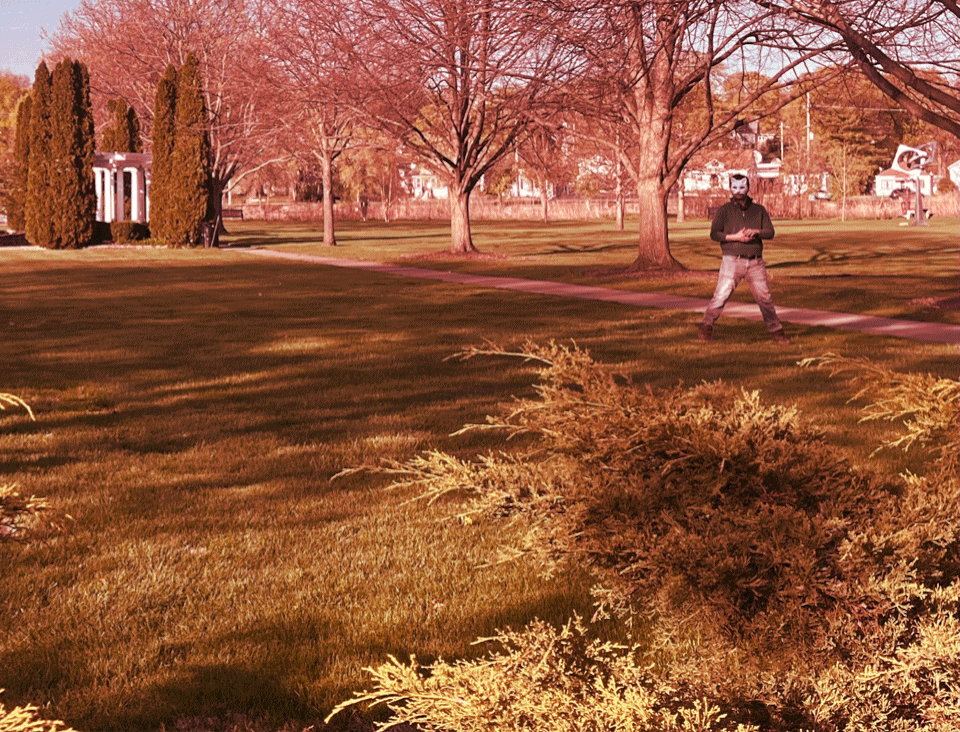Oh The Things We Fail To Notice…
4/28/23
Written by Camilla Dziadosz
As humans, we encounter quite a bit-wether that be visual, auditory, conceptual, or emotional information, and so on. With that being said, how much of it do we actually absorb and process? I mean think about it, is it even possible to take note of all that happens in our environment?
More often than not, we don’t notice changes that happen in our environment. Perhaps you disagree with that statement, since we also tend to believe we notice more than we actually do ;)
But for just one moment of your life, consider this following gif and see if you can detect a change.
Did you notice any changes within this gif? Not including the brief grey frame.
If you answered yes, excellent. What was it? If you answered no, well just please don’t ever volunteer to be an eye witness.
Just kidding.
It’s okay if you didn’t notice the shadow on the tree disappear from the one frame to the next. The failure to notice a large change in our environment is called Change-Blindness, a visual phenomenon in cognitive psychology.
Happens to all of us.
In this example, the way the gif is constructed mimics the way our eyes move, with the grey frame being the blinking of our eye, also referred to as “mud splats”. This is inevitable as our eyes are constantly moving, which is referred to as saccades. Saccades make thousands of tiny eye flutters every single minute… It’s interesting that when you zoom in on such basic functions of our experience, things seem even more complex.
Anywho, this kind of experiment/ activity is called saccade- contingent change tasks, and more specifically, the flicker paradigm or flicker task (Rensink et. al.) Psychologist Ron Rensink developed this task to research change blindness in the 1990’s. Although this phenomenon has roots that began in 1950, but didn’t gain traction or interest till Rensink’s research.
This task provides insight on how and why we miss such large objects in our environment, like severely obvious ones like that shadow on the tree.
Here is another example.
If you couldn’t detect the change in the last one, now is your chance to redeem yourself.
This is a particularly frightening example of change blindness, as it highlights that if you’re not vigilant, you can possibly be in danger.
If you didn’t notice, there is a person wearing a white cat mask to the far right of the gif staring right at you. Not to say anyone who wears this cat mask is dangerous (It’s one of my prized possesions), but generally it’s probably a good idea to be actively aware of who is around you. Change blindness emphasizes how vulnerable our perception is, and at times there are real implications due to this, especially when we are driving. Often we overestimate how much we notice in our environment, which is not entirely our fault as our brain would explode (metaphorically) if we noticed every single little thing. So, our brain takes short cuts, and we usually just get the gist of our environment, also known as Gist Processing which in turn creates the Grand Illusion of of Complete Perception in which once we get the gist, our brain tells us we have experienced and seen it all to keep moving forward in our life.
Of course there is a spectrum for how much one notices in their environment and it is not the same for everyone.
What we chose to notice and attend to in our lives is unique to us, not everyone will notice and look for the same things. Factors such as culture, personality, gender, expertise, and cognitive abilities influence the way change blindness presents itself in our lives. Our perception is shaped by all these things, and depending on what we expect to see or find important, we are more likely to see just that, and whatever we don’t expect to see, may just not see that.
Interesting research findings highlight that collectivist societies and individuals tend to notice changes in a larger context more so than individualistic societies and individuals. This finding suggests that the way we think does effect the way we view, interpret, and experience our reality. May sound sort of like common sense, but with this knowledge it can be used to your advantage. If you look for positive things, or whatever it may be, you are more likely to see that. Which is interesting and inspiring in the sense that in a way YOU shape your reality.
Although expectations and more unique factors like personality, cognitive abilities, and gender have a strong guide to how change blindness presents itself, the phenomenon is mostly understood through attention and memory components. Although recent research is delving into those unique individual components.
That being said, our attention is generally limited. Due to this we can attend to only one thing at a time. So, you can imagine all the things we miss if our focus is on one particular thing at one given moment. Changes in focal point subjects are also more easily detected due to it being right in front of us. But it’s not always the most obvious subjects that we notice, it’s really anything YOU find important, which again varies from person to person.
Although noticing a change relies on first having it get your attention, it also means you have to remember what you even saw.
Remember the saccades, or the brief grey screen in the gifs? Those “blinking” interruptions are what interferes with our visual memory.
Our ability to store information in our memory is called encoding. If we haven’t encoded what something looked like in one moment, we will not be able to detect what changed in the next. Saccades are the main culprit to this visual memory interruption. This failure to encode has often been tested with film in which participants don’t notice chnages to central actors. Although, participants in other studies have surprisingly been able to detect a change without actually knowing what the change was, and this notion has been refrered to by Rensink (2004) as mindsight, which is really this “sense” or “gut-feeling”.
The flicker task is able to test this notion of the before and after comparison of our visual perception, but in our everyday lives there really is no way of knowing what we did or didn’t see… which is alarming but also fascinating. That being said, even with the flicker task presenting a before and after sequence, change blindness STILL occurs. So imagine the prevelance of it in our everyday lives.
Change blindness can be applied and helpful in our everyday life as it emphasizes how vital our awareness is regarding physical and mental well being for the better or worse. It’s important for us to acknowledge the strength of our thoughts in relation to our visual perception. Often we seperate our mind from our body experience, but they work together in ways we are still understanding. This phenomenon should also remind you that your safety should be prioritzed, our perception is a tad flakey, so be careful out there ;)
SOURCES
Attwood JE, Kennard C, Harris J, Humphreys G and Antoniades CA (2018) A Comparison of Change Blindness in Real-World and On-Screen Viewing of Museum Artefacts. Front. Psychol.
O'Regan, J., Rensink, R. & Clark, J. Change-blindness as a result of ‘mudsplashes’. Nature 398, 34 (1999).
Simons, D. J., & Ambinder, M. S. (2005). Change Blindness: Theory and Consequences. Current Directions in Psychological Science, 14(1), 44–48.
Simons DJ, Rensink RA. Change blindness: past, present, and future. Trends Cogn Sci. 2005 Jan;9(1):16-20.


